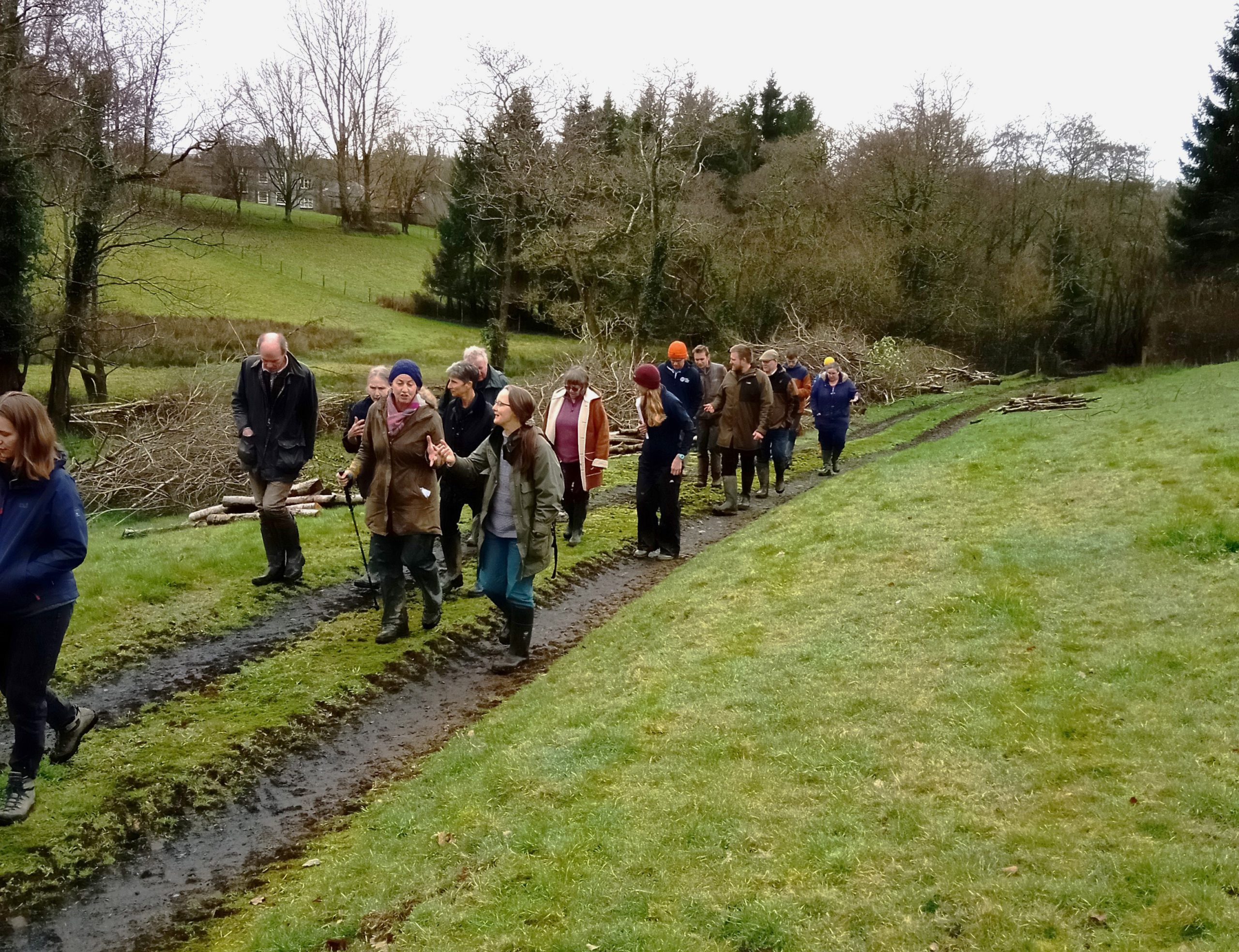
A Farm Net Zero (FNZ) event held in February at Roger and Lavinia Halliday’s FNZ monitor farm.
Hedgerows are an important part of the UK’s agricultural landscape; they support wildlife, shelter livestock and crops and capture carbon. To learn more about hedges and their multiple benefits, a group of farmers and advisors met at Browda, Linkinhorne to hear how Roger and Lavinia Halliday manage nearly 18 kilometres of hedge on their 250-acre organic suckler beef farm. This event was made possible with thanks to the National Lottery Community Fund who fund the Farm Net Zero project.
Hedges at Browda are part of a Countryside Stewardship agreement with a BE3 “Management of Hedgerows” annual payment and are laid on a 12-20 year rotation under the BN5 hedgerow-laying capital option. This work is completed by a hedge-laying contractor, with the stewardship payment covering their costs (but not the additional cost of clearing up, done by Roger, and any fence repairs). Hedges are laid in the vernacular Cornish hedge style to create a thick, dense hedge. Any log wood cut out of the hedge is then processed by Roger for fuel for the farmhouse biomass log boiler and the remaining brash either burnt or tipped in a corner to rot down. This prompted a discussion on the opportunities to make use of the brash with suggestions including chipping it for cattle bedding or garden mulch. Dr. Rob Wolton, ecologist and chairman of the Devon Hedge Group, said that the brash creates an important habitat as it decomposes so it is useful to leave some. It is good to leave saplings to grow into hedgerow trees for wildlife and livestock shelter. There are approximately 800 of these at Browda. They need not be perfect specimens and dead trees are also valuable habitat.
Dr. Wolton also spoke about the importance of managing hedges on a rotation to create a range of habitats to boost biodiversity. Laying is the best way of achieving this, but flailing is also effective if done sensitively, allowing the hedge to grow out a little more between successive flails and avoiding flailing at the same level each year. This was an important reminder that the flail is just a tool, it can be used poorly but can also be used well. Tree shears can be used to quickly and efficiently coppice hedges and restart the management cycle, with the added advantage that trees can be lifted clear to avoid damage to fences. Likewise, hedges can be layed mechanically, saving a great deal of manual work and time.

Clockwise from top left: laid hedge and brash cut for processing, side flailed hedge, 5-year old regrowth on laid hedge.
Laying, incremental flailing and cutting on a rotation are all supported through both Countryside Stewardship and the new Sustainable Farming Incentive Hedgerow Standards, along with coppicing, filling in gaps and planting new hedgerows.
Roger and Lavinia have previously made use of grants for planting new hedges, shelterbelts and farm woodlands, aiding the grazing management and creating wildlife corridors and refuges. Emma Eberhardt from Cornwall Council’s Forest for Cornwall programme gave an overview of what they can support. Forest for Cornwall aims to increase tree cover in Cornwall and can provide advice to landowners looking to plant trees either as woodland or hedges, including fully funded planting support (free trees and guards). Emma is involved in developing a network of agroforestry demonstration sites across Cornwall to show how trees and agriculture can work together.
Becky Willson from Farm Carbon Toolkit talked about the carbon benefits of hedgerows. At Browda, hedges are capturing nearly 86 tonnes of CO₂e every year and the hedgerow trees are capturing an additional 40 tCO₂e, this is 43% of the farm’s total sequestration and offsets 24% of the farm’s emissions. Becky spoke about the new Hedgerow Carbon Code being developed as a route for private finance to pay for carbon stored in hedgerows. This is currently working on an estimate that carbon is stored in hedges for around 10 years, so could fit well with a management rotation. However, it is still in development and not expected to be launched until later this year.
Key takeaways:
- Hedges lock-up carbon as they grow, bushier hedges have more carbon than small hedges.
- It is important to maintain a diversity of hedge types to increase the range of available habitats.
- There are several grant options for hedge planting and management that are worth investigating.

This event was made possible with thanks to the National Lottery Community Fund who fund the Farm Net Zero project.

